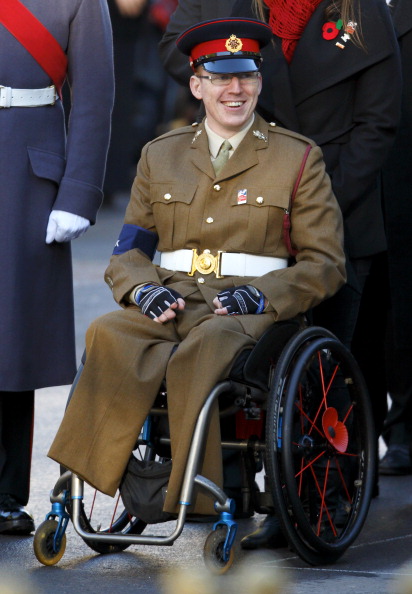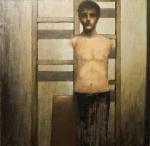October 8, 2014 - 18:38

Vulnerable Bodies: Pride and Shame in Amputee Portraits
Sula Malina
October 8th, 2014


War veterans have been the subjects of portraits for centuries—from the proud general posing for an oil painting, to the black and white photograph of the soldier in the trenches. This portraiture has exposed the veteran’s body in a way that many bodies are never seen—we see ample muscle, powerful build, and visible disability, all in one image. Perhaps this is why it seems that images of veterans are the most common exposure the public has to images of amputation. A prime example is the image of a British veteran, wheeling through a procession at Remembrance Sunday, a significant annual memorial for those who are or were a part of the British Armed Forces. Portraits of veterans naturally inspire pride in many viewers, or at least some level of gratitude for the individual’s brave sacrifice. However, the majority of amputee portraits are not of these heroic figures—rather, they portray the average civilian. Paul Fiore’s painting entitled “Amputee” serves as an example of this. The image is a striking one, to be sure—at first glance, we see a naked torso, immediately exposing the amputated parts of the body. The audience, having no real knowledge of this ambiguous man’s background, has no reason to see him as a man with a victorious or brave past, and likely assume he is a civilian. The stark contrast between the two images, primarily in their polar moods that are represented through artistic means, bring us to question how the images are framed to make the audience view one as more worthy of pride and respect than the other. As demonstrated by Fiore’s “Amputee” and the photograph of the amputee soldier, war veterans, by virtue of their occupation, are read both in life and portraiture as powerful figures, rather than mere bodies, and are thus presented in portraiture as less vulnerable and less easily objectified.
Though these two portraits have many characteristics in common, they are used to represent nearly completely opposite ideas and moods. Fiore’s painting features three edges of blackness that frame the image, drawing what seems to be unwanted attention to the subject’s naked torso. Similarly, the Remembrance Sunday photograph is framed in black—however, this black is worn by those around the subject who have donned the color in order to comemmorate or offer gratitude to those who have served their country. Both have senses of melancholy and mourning, but the photograph turns this mourning into a celebration—hence the fact that Remembrance Sunday is a holiday. In fact, the entire color palettes of both images are fairly similar, primarily made up of blacks, browns, and tans. Yet in Fiore’s painting, this is used to draw attention to the naked, vulnerable amputated body—and in the photograph, the paleness of the veteran’s skin and the comparative lightness of his uniform imply his status as angelic and hopeful. This may, in part, be due to the quality of the brightness—the lightest section of the painting appears to be harsher light, as compared to the photograph, which features much softer, natural lighting.
Interestingly, the very aspects of these images which would conventionally take away a sense of power seem to provide it, and vice versa. A significant example of this is the pose featured in both portraits. In “Amputee,” Fiore paints his subject standing perfectly upright, legs together, and head facing forward. However, it is purely because he is facing completely forward that the audience has a full view of his vulnerable, naked torso and the shoulders from which his arms have been amputated. In contrast, the subject of the Remembrance Sunday photo is sitting in a wheelchair, a position that is often portrayed as powerless and compromising—particularly because he is being pushed by someone. However, given the background provided on the photo, it is apparent that the veteran is being pushed by someone else so that he may be honored for his service, and as a result, his seated position conjures an image of a king on a throne—rather than the conventional image of the sad, disabled individual “confined” to a chair. The subject’s relaxed posture and comfortable body language communicate as much.
A similar unusual situation arrises in looking at the subjects’ gazes in both portraits. While the half-naked man in “Amputee” appears to be facing directly forward, because his eyes are in shadow, the audience cannot exactly feel looked at. Quite often, in images featuring such vulnerable bodies (such as naked ones), the provoked voyeurism is counteracted by the challenging stare of the subject; however, in Fiore’s painting, the subject’s eyes cannot be seen, almost as though he has hidden them in shame. This utter lack of gaze effectively removes a sense of humanity from the subject, and the audience is almost invited to look in on the man’s naked torso as an object, rather than a part of a person. In contrast, the subject of the Remembrance Sunday photo appears to be looking to the side, perhaps at a smiling civilian or a fellow veteran. Here, it is his lack of focus back at the camera that gives him power, as though he has more significant interactions to have than whatever he might engage in with the photographer. The veteran in the image seems to be honorable and desired, again perpetuating this sense of “king on his throne.” He is portrayed not as a “broken body,” but as an important figure or celebrity whose presence is too grand to be objectified.
It is important to note that the subject in Fiore’s “Amputee” is defined by what he cannot do, while the subject of the Remembrance Sunday photograph is defined by what he has already done. The half-naked, painted subject is positioned slightly off-center, revealing behind him what appear to be two ladders and a suitcase. All three of these items imply a need for funtioning hands and arms, and as such, reduce the man in the portrait to merely a dysfunctional body. The injured veteran, on the other hand, is placed directly in the middle of a photo meant to document a commerative event—this man is being honored for his brave efforts and great strength—and as a result, his injuries do not matter so much, because he has already successfully fought for his country. This notion of “cans” and “cannots” is perpetuated through the subjects’ clothing; while the man in the painting is half-naked, immediately making him vulnerable, the veteran is adorned in his uniform, and a medal is pinned to his chest. His eyeglasses, paired with the clean and sharp nature of his costume suggest intelligence, wealth, and power, which are not minimized by the fact that he is in a wheelchair. This uniform again transforms the subject into a figure, rather than a naked object, and as such, his disability seems less of an impairment than it does for the half-naked subject of “Amputee.”
It is impossible to write about the portrayal of veteran amputees in art without considering the most common source of interaction between civilians and wounded veterans—out on the streets. Driving through busy intersections in cities, it is very likely that one will come across a panhandling, disabled vet, often missing a limb, who has simply not been offered the resources to have food or shelter after returning from war. Though the man in the Remembrance Sunday photo is a real veteran, and though his life is not one of panhandling for a living, neither is his life as constantly glorious as how it is portrayed in this photograph. The photograph may be problematic in that it presents a single story of the life of a war-wounded veteran, but it does offer an alternative representation to how most people see veteran amputees—as homeless people conjuring pity and melancholy. In this sense, the representation of wounded veterans as glorified and worthy of praise and honor seems socially significant in a positive way—it alters civilians’ understandings of war-wounded bodies without weaving tales of the supercrip (as the disability has been acquired after the tremendous feat).
How, then, does this alternate, glorified representation of war-wounded veterans affect an audience’s viewing of a disabled, civilian body? The veteran amputee subject, as it continues to be portrayed in portraiture, seems to have all the advantages that portraiture has to offer: the body is glorified, almost put up on a pedestal, and completely escapes the fate of the supercrip, as he has acquired the disability through his noble action. It seems, then, that the civilian amputee body is left with few options; it can be represented in a shameful, despondent image such as Fiore’s “Amputee,” or it can become the supercrip, who can climb ladders and carry a suitcase even without arms.
In examining this dilemma, it seems significant to question Fiore’s intentions in painting “Amputee.” Paul Fiore does not speak of having a visible disability himself, nor is he vocal about having a close affiliation with a friend or family member who does. His other work does not suggest a background in the disability rights movement, and the brief note included on his website about the incomplete nature of the portrait seems almost careless. Could Fiore really care about the vulnerability of his subject? It is hard to say, given that one cannot know what Fiore intends to change as he transitions into his final product—perhaps the faded edges of the subject’s shoulders would become sharper, or perhaps he might choose to leave them blurred. One may never truly know whether Fiore intended to portray an amputee who is “rightfully” shameful of his disability, or whether this image was meant to serve as commentary on society’s tendency to objectify the disabled and reduce them to mere bodies. Assuming, hopefully, that the latter is the case, Fiore’s post pairs quite nicely with the Remembrance Sunday photo—the first being a guilt-ridden voyeuristic glimpse at the objectified body of the civilian, and the second being the glorified, celebritized figure that is the war-wounded soldier.
